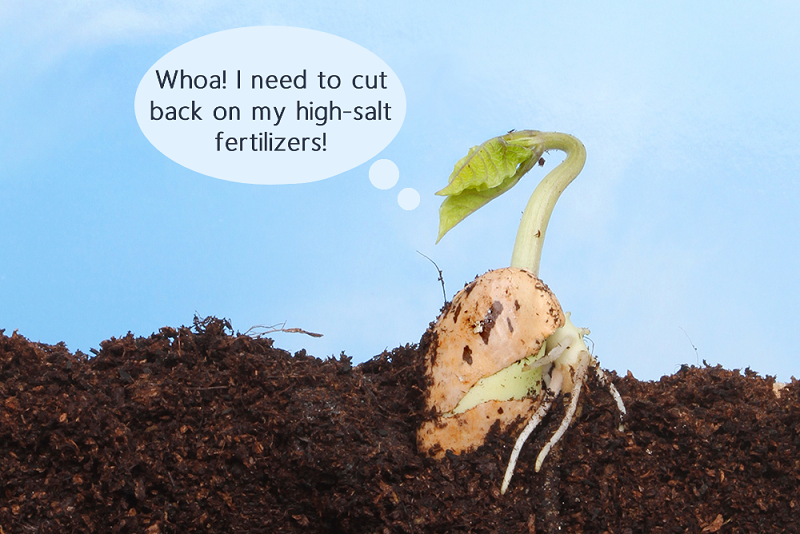
Exhibition time: 17-19 March, 2026 Shanghai, China
 中文
中文

Exhibition time: 17-19 March, 2026 Shanghai, China
 中文
中文

Please hold the salt!
You’re sitting on the examination table in the doctor’s office. Your physician comes into the room, looks at your chart, and says with a small frown, “Your blood pressure is high. You need to cut down on your salt intake.”
Excessive salt isn’t just a concern for us humans. It can pose serious seed health and safety concerns. And like much of the food we eat these days, traditional fertilizers can be quite high in salt content. So what is a grower to do?
It starts by understanding how much salt is in the fertilizers we use and how this can detrimentally impact a seed and roots, and ultimately yield potential. With this knowledge, we can look at salt index as criteria to use when choosing and applying a fertilizer – and possibly consider using one of the growing numbers of low salt fertilizers now available for use in agricultural applications.
Most ingredients found in fertilizers are readily soluble in the soil (and thus, available to plants). This is because they are salts.
Salt index (commonly referred to as fertilizer salts) is a measurement that indicates the degree that the fertilizer will increase salt concentration (and the osmotic pressure) of the soil solution.
It can be used as a general guideline when selecting fertilizers in relation to seed safety, and to determine the best approach to seed placement when using Seed Bed Utilization (SBU).
The chart below provides the salt index for several of the most commonly used fertilizers for a convenient side-by-side comparison.
It is important to note that the salt index will not tell you what amounts of fertilizer you can safely use or the type of formulation to avoid injury. The potential of salt injury also depends on additional factors outside of the fertilizer used.

Source: A&L Great Lakes Laboratories – algreatlakes.com
When applied too closely, fertilizers with a high salt index can rob germinating seed of moisture – resulting in injury or death.
This occurs when the concentration of fertilizer salt in the seed row is higher than the concentration of natural salts within the seed. The higher osmotic pressure in the soil will cause the water to be drawn from the seed and into the soil solution.
In situations where there is not adequate soil moisture (such as dry conditions after seeding), or cooler soil temperatures, the risk of salt damage due to osmosis increases as fertilizer salts become more concentrated.
This is why it is important to apply fertilizer at the appropriate rates and in the recommended manner.
A quick look at the chart above reveals that the salt index can vary dramatically depending on the type of fertilizer you use. An at a glance look can reveal which fertilizers have a higher risk of injury.
As you’ll notice, the salt index numbers are generally lower for the Phosphorus category. However, we must remember that due to its lack of mobility in the soil solutions, Phosphorus must be placed as close to the seed as possible (usually by banding), which increases the risk of injury, despite the lower salt index.
As an industry, fertilizer companies have identified the need to introduce products with a lower salt index to address both agronomic (crop safety) and sustainability concerns.
Two new low-salt fertilizers have been included on this chart as a comparison.
Environmental regulations have reduced the amount of sulphur deposited in the soil from the atmosphere, leading to a greater need for fertilizers containing Sulphur. Yet Sulphur fertilizers can be high in fertilizer salt. SUL4R-PLUS® has a lower salt index than other S fertilizers (less than 8) and allows growers to apply it in furrow without risk of damaging the seed. Plus, its high solubility formulation means Sulphur is available to the plant almost as soon as it is applied – and on plant demand.
Crystal Green® is an innovative fertilizer with a salt index 66% lower than standard P fertilizers. Interestingly, it is released by plant-root demand and is not soluble in the soil – which further protects against seed injury. While it is meant to replace 25% of the existing Phosphorus fertilizer, this lowers the overall fertilizer salt index and helps increase seed safety.
New fertilizers such as these represent a changing mindset and are proving to be highly effective and increase overall performance.
The reason salt index cannot be used to determine application rates is that there are a number of other factors that can contribute to the risk of injury. This includes the soil type, soil moisture, row spacing, the type of crop and fertilizer placement.
Coarse, textured soils and dry soils are more vulnerable, due to the lack of moisture. Wide row spacing can also be a concern, as it generally requires higher seeding and fertilizer rates.
Also, different crops have different sensitivity levels to fertilizer salts. Canola is highly sensitive, followed by soybeans/edible beans, forage legumes, corn and wheat, in order of most sensitive to least.
Canola seed is particularly sensitive to Nitrogen, Sulphur and Phosphorus fertilizers, so care must be taken in going with lower rates. Side-band or mid-row placement is generally recommended. The Canola Council of Canada says that safe rates for N and S fertilizer may be as low as 10 kg/ha (10 lb./ac.) depending on row spacing, seed and fertilizer separation in the row, soil moisture conditions, and soil type.
It is important to know the recommended rates and application methods based on your crop and your growing conditions. Seedbed utilization (the ratio of seed row width to seed row spacing) will be an important factor in determining both seed placement and fertilizer rates.Regular soil testing can also be valuable in helping you calculate the required fertilizer rates.
Whether it is people or plants, moving to a lower salt diet has been shown to reduce health risks. With more and more low-salt alternatives on the market, cutting salt is easier than ever. And by holding the salt, you may be able to savour even greater yield potential.
